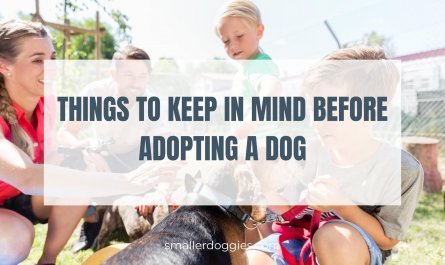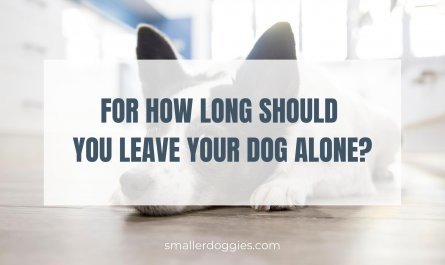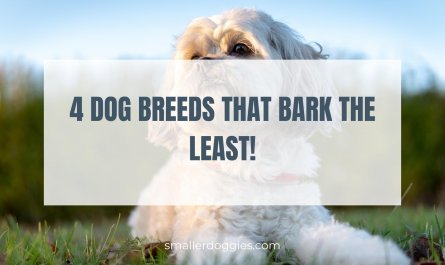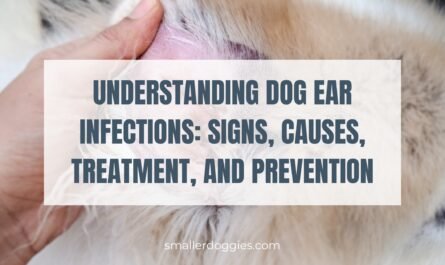Post Disclaimer
This post may contain affiliate links. If you use these links to buy something we earn a commission at no extra cost to you. Smaller Doggies is supported by its audience, Thank you!
If you’re an allergy sufferer and love dogs, you know the struggle of finding a furry companion that won’t trigger your symptoms. Fortunately, there are several small dog breeds that don’t shed or shed minimally, making them a great choice for those with allergies. In this article, we’ll introduce you to the top 7 small dog breeds that don’t shed, so you can find your perfect match.
Understanding hypoallergenic breeds is important when searching for a dog that won’t trigger your allergies. While no dog is 100% hypoallergenic, some breeds produce less dander than others, which is a common cause of allergic reactions. Non-shedding breeds are often recommended for allergy sufferers since they produce less dander and hair, making them a better choice for those with allergies.
Without further ado, let’s dive into the top small hypoallergenic dogs that don’t shed. Whether you’re looking for your first pet or looking to adopt, there’s sure to be a breed that will fit your lifestyle and personality.

Understanding Hypoallergenic Breeds
What Makes a Dog Hypoallergenic?
If you’re an allergy sufferer, you might have heard of hypoallergenic dog breeds. But what exactly makes a dog hypoallergenic? Hypoallergenic breeds produce fewer allergens than other breeds, making them less likely to trigger an allergic reaction.
One common misconception is that hypoallergenic breeds don’t produce any allergens at all. However, no dog breed is completely hypoallergenic. Even so-called hypoallergenic breeds produce some allergens, but in smaller amounts.
Common Allergens and How Dogs Produce Them
The most common allergen produced by dogs is a protein called Can f 1, which is found in a dog’s saliva, urine, and dander. Dander is made up of tiny flakes of skin that dogs shed, and it can become airborne and spread throughout your home.
While all dogs produce Can f 1, some breeds produce less of it than others. Hypoallergenic breeds tend to have hair instead of fur, which means they shed less and produce less dander. In addition, some breeds have coats that trap dander close to the skin, making it less likely to become airborne.
It’s also important to note that some people are more sensitive to certain allergens than others. So while one person might be able to tolerate a certain breed, another person might have a severe reaction to the same breed.
Now that you have a better understanding of what makes a dog hypoallergenic and how dogs produce allergens, let’s look at some of the top small dog breeds that are better suited for allergy sufferers.
Top Small Dog Breeds That Don’t Shed
If you’re looking for a small dog that won’t trigger your allergies, you’re in luck! There are plenty of small, hypoallergenic dog breeds to choose from. These dogs produce less dander, hair, and saliva, making them a great choice for allergy sufferers.
Maltese
The Maltese is a small, white, and fluffy dog that is known for its hypoallergenic coat. This breed is gentle, affectionate, and loves to be around people. Maltese dogs are also very intelligent and easy to train, making them a great choice for first-time dog owners.
Bichon Frise
The Bichon Frise is a small dog breed that is known for its curly, hypoallergenic coat. This breed is playful, affectionate, and loves to be around people. Bichon Frises are also very intelligent and easy to train, making them a great choice for families with children.
Shih Tzu
The Shih Tzu is a small dog breed that is known for its long, silky, hypoallergenic coat. This breed is friendly, playful, and loves to be around people. Shih Tzus are also very intelligent and easy to train, making them a great choice for families with children.
Miniature Schnauzer
The Miniature Schnauzer is a small dog breed that is known for its wiry, hypoallergenic coat. This breed is loyal, intelligent, and loves to be around people. Miniature Schnauzers are also very easy to train and make great watchdogs.
Chinese Crested
The Chinese Crested is a small dog breed that is known for its hairless or hypoallergenic coat. This breed is playful, affectionate, and loves to be around people. Chinese Crested are also very intelligent and easy to train, making them a great choice for families with children.
Yorkshire Terrier
The Yorkshire Terrier is a small dog breed that is known for its long, silky, hypoallergenic coat. This breed is energetic, playful, and loves to be around people. Yorkshire Terriers are also very intelligent and easy to train, making them a great choice for families with children.
Havanese
The Havanese is a small dog breed that is known for its long, silky, hypoallergenic coat. This breed is friendly, affectionate, and loves to be around people. Havanese dogs are also very intelligent and easy to train, making them a great choice for families with children.
Overall, these small, hypoallergenic dog breeds are a great choice for allergy sufferers who want a furry companion. With their hypoallergenic coats and friendly personalities, they are sure to make great pets for years to come.
Grooming and Care for Low-Shedding Breeds
If you’re considering getting a low-shedding dog, it’s important to understand their grooming needs. While these breeds don’t shed much, they still require regular grooming to keep their coats healthy and free of tangles.
Regular Grooming Needs
Low-shedding breeds typically have curly or silky coats that require regular brushing to prevent matting and tangling. Depending on the breed, you may also need to trim their hair every few months to keep it at a manageable length.
One important aspect of grooming low-shedding breeds is keeping their undercoats in good condition. While these dogs don’t shed much, their undercoats can still trap dirt and debris, leading to skin irritation. Regular brushing and bathing can help keep the undercoat clean and healthy.
Managing Shedding and Dander
While low-shedding breeds don’t produce much hair, they can still produce dander, which can trigger allergies in some people. To manage shedding and dander, it’s important to keep your dog’s coat clean and well-groomed.
Regular bathing can help remove excess dander and keep your dog’s skin healthy. You may also want to consider using a pet-specific vacuum to remove any loose hair and dander from your home.
Overall, low-shedding breeds are a great option for allergy sufferers, but they do require regular grooming and care to keep their coat healthy and free of tangles. With proper grooming and attention, these dogs can make wonderful companions for anyone looking for a low-shedding pet.
Choosing the Right Hypoallergenic Small Dog For You
If you are looking for a small dog that doesn’t shed, you have several options to choose from. However, before you make your final decision, you need to assess your lifestyle and allergy needs. Here are some factors to consider:
Assessing Your Lifestyle and Allergy Needs
First, consider your living situation. If you live in a small apartment, you may prefer a small dog breed that doesn’t need a lot of exercise. Some hypoallergenic small dog breeds, like the Bichon Frise and the Havanese, are lap dogs that love to cuddle and don’t require a lot of space.
Next, consider your allergy needs. While no dog is completely hypoallergenic, some breeds are less likely to cause allergic reactions than others. For example, the poodle is a popular hypoallergenic dog breed because it has a non-shedding coat. Other hypoallergenic small dog breeds include the Maltese, the Shih Tzu, and the Yorkshire Terrier.
Where to Find Hypoallergenic Dogs to Buy or Adopt
If you’re interested in adopting a hypoallergenic small dog, there are several places to look. One option is to check out the AKC Marketplace, which lists breeders who specialize in hypoallergenic dog breeds. You can also search for breeders in your area using online directories like PuppyFind.com or the American Kennel Club’s Breeder Referral Search. Another option is to check out local animal shelters and rescue organizations.
In conclusion, when choosing the right hypoallergenic small dog, it’s important to consider your lifestyle and allergy needs. Take the time to research different breeds and adoption options to find the perfect companion that fits your needs.
Frequently Asked Questions
Which calm and quiet small dogs are also hypoallergenic?
If you’re looking for a small dog that is both hypoallergenic and calm, you might want to consider the Bolognese. This breed is known for being friendly, gentle, and quiet. They also have a hypoallergenic coat that doesn’t shed much. Another option is the Havanese, which is a playful and affectionate breed that is also hypoallergenic. They are known for being quiet and adaptable to different living situations.
What are the most budget-friendly hypoallergenic small dogs?
If you’re on a tight budget but still want a hypoallergenic small dog, consider the Chinese Crested. They are a hairless breed that doesn’t shed much, and they are generally less expensive than other hypoallergenic breeds. Another option is the Miniature Schnauzer, which is a small and hypoallergenic breed that is also known for being intelligent and easy to train.
Which is the smallest dog breed that is both hypoallergenic and non-shedding?
The Bichon Frise is one of the smallest dog breeds that is both hypoallergenic and non-shedding. They are known for their fluffy white coat, which doesn’t shed much and is hypoallergenic. They are also a friendly and playful breed that is great with children.
What are the top intelligent small dog breeds that are also hypoallergenic?
If you’re looking for a small dog that is both hypoallergenic and intelligent, consider the poodle. They are a highly intelligent breed that is known for being easy to train. They also have a hypoallergenic coat that doesn’t shed much. Another option is the Miniature Schnauzer, which is also a smart and hypoallergenic breed that is easy to train.
Remember, while these breeds may produce fewer allergens, regular grooming and care remain essential. By assessing your lifestyle, allergy needs, and considering budget-friendly options, you can find the perfect hypoallergenic small dog that fits seamlessly into your life.







